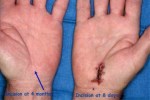For a slide show, see below:
Carpal Tunnel Syndrome
Carpal comes from the Greek word karpos, which just means wrist. Carpal tunnel then just means wrist tunnel. The carpal tunnel is formed at the wrist by the wrist bones below and a ligament above. There are nine tendons and one nerve (the median nerve) which pass through the tunnel. When pressure is increased in the tunnel, the tendons don’t seem to mind, but the nerve does. The nerve cannot function normally when the pressure around it is increased. It is like stepping on a garden hose – the water coming out will only trickle instead of flow.
wrist by the wrist bones below and a ligament above. There are nine tendons and one nerve (the median nerve) which pass through the tunnel. When pressure is increased in the tunnel, the tendons don’t seem to mind, but the nerve does. The nerve cannot function normally when the pressure around it is increased. It is like stepping on a garden hose – the water coming out will only trickle instead of flow.
 The (median) nerve provides sensation to the tips of the thumb as well as index, middle, and part of the ring fingers. The nerve is also needed to stimulate muscles in the palm which move the thumb. Increased pressure on the nerve can cause tingling in some or all of the fingers and weakness in the hand. Symptoms are often worse at night and sometimes people report they are awakened with discomfort and need to “shake” their hand to improve the “circulation”. An examination by a physician is required to make the diagnosis of carpal tunnel syndrome. Evaluation may include special electrical tests.
The (median) nerve provides sensation to the tips of the thumb as well as index, middle, and part of the ring fingers. The nerve is also needed to stimulate muscles in the palm which move the thumb. Increased pressure on the nerve can cause tingling in some or all of the fingers and weakness in the hand. Symptoms are often worse at night and sometimes people report they are awakened with discomfort and need to “shake” their hand to improve the “circulation”. An examination by a physician is required to make the diagnosis of carpal tunnel syndrome. Evaluation may include special electrical tests.
CONSERVATIVE TREATMENT:
For early and mild cases, treatment may start with night and/or day splinting. Flexion of the wrist adds a small amount of pressure to the canal, and splinting helps to keep the wrist extended or straight. This is especially important at night, since while someone sleeps, the wrist is often held flexed. Other treatments may include anti-inflammatory medication, and local steroid injection. There is a good stretch for the nerve which often helps relieve symptoms. It should be done 3 times in a row (hold the position for 10 seconds), three times a day (see photo below).
CTS AND PREGNANCY:
Pregnant women, because of fluid retention, are at risk of developing CTS. This is a temporary condition which usually resolves after delivery. It can be treated during pregnancy with a steroid injection and is safe for the baby after the first trimester.
SURGICAL TREATMENT:
If the nerve compression is severe or not relieved after conservative treatment, surgery may be necessary. This involves releasing the ligament which forms the top or roof of the canal. This relieves pressure on the nerve. Surgery is done on an outpatient basis under local or regional anesthesia. The patient wears a dressing for 1-2 weeks after surgery and leaves the fingers free for daily activities. Healing continues for many months with gradual improvement in finger-tip sensation and decreasing scar tenderness. Stretching is done after surgery 3 times a day for a few minutes each.
Slide Show:

